In the dynamic world of sports, the connection between fans and their favorite teams is more than just fandom. It’s an emotional roller-coaster, a shared journey of success and failure. Because we saw such commitment was often overlooked by sports organizations, our team Argonauts participated in MonstarHacks 2024 challenges with a mission to transform fan engagement. Our solution not only rewards superfans for their dedication but also fosters positive online communities by providing valuable insights to teams through our comprehensive dashboard.
How we envisioned TALOS
We believe that by gamifying fan engagement, we can encourage and reward supporters for their unwavering support for their club. Through our platform, followers earn points for various interactions such as social media engagement, event attendance, and participation in club-related activities. These points act as currency, offering fans exciting prizes ranging from team jerseys and caps to the most desired tickets to the finals, as well as the chance to meet their favorite players which we think is the ultimate reward for a fan.
But our innovation doesn’t stop there. In today’s digital age, social media has become an integral part of the sports fans's lives. However, it’s not uncommon for this to turn toxic and spoil the spirit of the game. That’s where our solution steps in with its unique characteristic, it uses data from social platforms to identify and prevent toxic behaviour. By implementing a system that deducts points for toxic behavior, we aim to create a healthy and inclusive online community by biasing towards positive attitudes and encourage true sportsmanship among the followers.
For sports teams, understanding fan behavior and emotions is essential for improving their strategies both on and off the field. That’s why we created a robust dashboard that gives teams access to valuable insights gained from fan interactions. From monitoring engagement metrics to monitoring sentiment analytics, teams gain a holistic understanding of their fan base, allowing them to tweak their marketing efforts, improve fan experience, and deepen their relationships with their supporters.
Essentially, our solution is a win-win for all stakeholders. Followers are rewarded for their fandom and teams gain valuable insights of their fans and business.
Technical architecture insights
The architecture that supports our solution is serverless, which enables a pay-as-you-go service model. This approach will prove highly cost-effective in the long term as demand increases for our app. We utilize AWS Fargate to seamlessly deploy our three services. These services connect our app with social media platforms, extract data from social media posts, and securely store it in an S3 bucket. Additionally, AWS Step Functions orchestrate the smooth processing of steps for our AI/ML tools, ensuring efficient and reliable execution of tasks.
At the core of our architecture, we embrace the cutting-edge capabilities of three powerful AI/ML services offered by AWS. Firstly, AWS Personalizes categorizes sports fans into loyal and seasonal groups, allowing for tailored recommendations based on their preferences. Next, Amazon Comprehend analyzes social media posts to understand fan sentiments, entities, and key phrases, providing valuable insights into fan emotions and preferences. Lastly, Amazon Rekognition deciphers visual content from images and videos shared by fans, identifying objects, people, text, scenes, and activities, enriching our understanding of fan engagement. Together, these services form the foundation of our solution, enhancing the overall fan experience in the APAC region and beyond.
As we will analyze large sets of data that are coming from the users' social media accounts, we need to ensure every piece finds its perfect place. To generate precise insights we will collect, extract, and organize the raw data using S3 Bucket, AWS DynamoDB, AWS Glue, AWS Athena and AWS RDS.
Last but not least, to ensure that our analysis is thorough and insightful, we employ AWS Location Service to pinpoint regions with the highest social media activity, helping us target specific demographics effectively. Additionally, AWS QuickSight provides visual data analytics for our B2B services, enabling us to gain valuable insights and make informed decisions based on the data collected and analyzed from social media platforms.
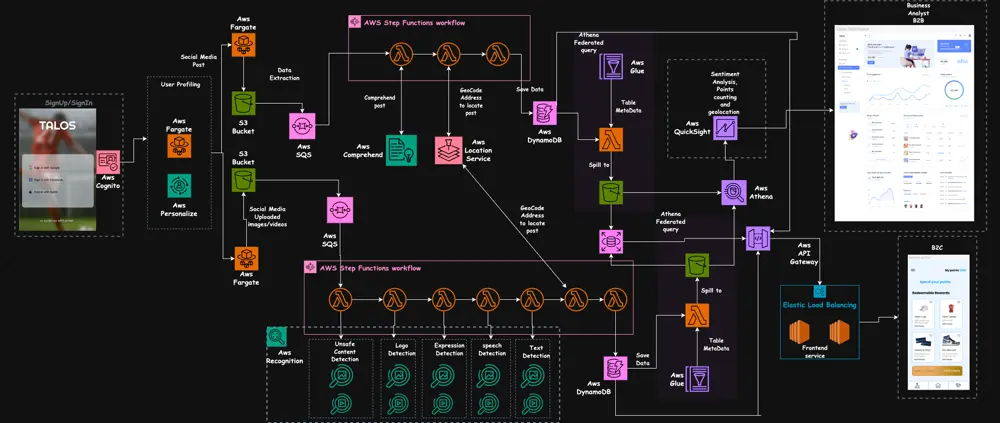
Let's simplify our large AWS diagram by breaking it into smaller pieces for easier explanation.
User Authentication And Data Extraction
In this step, users sign up using AWS Cognito for authentication. Then, they answer questions to identify their favorite club/league, with AWS Personalize guiding the process. Next, users add their social media accounts to our app, which is managed by AWS Fargate. After adding their social media accounts, AWS Personalize again analyzes users' social media activity to identify their true fan identity and develop personalized recommendations. Additionally, another AWS Fargate service fetches public data from users'social media accounts and saves the data to an S3 bucket for further use.
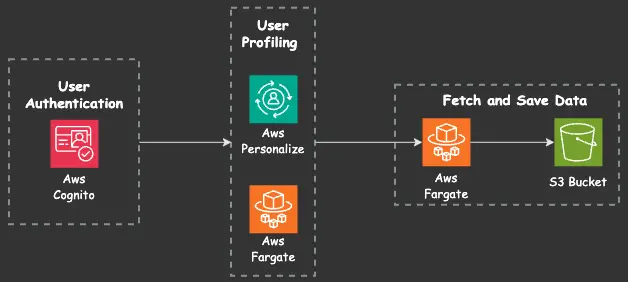
User Social Media Post Analysis
In this step, AWS AI/ML services play a big role. Two services run together: one analyzes users' social media posts with AWS Comprehend, while the other analyzes users' photos/videos with AWS Rekognition. AWS Step Functions coordinate these analyses, with multiple Lambda functions executing based on our algorithm. Additionally, AWS Location Services identify the location of social media activity. After analyzing and extracting all the data, it's saved in AWS DynamoDB.
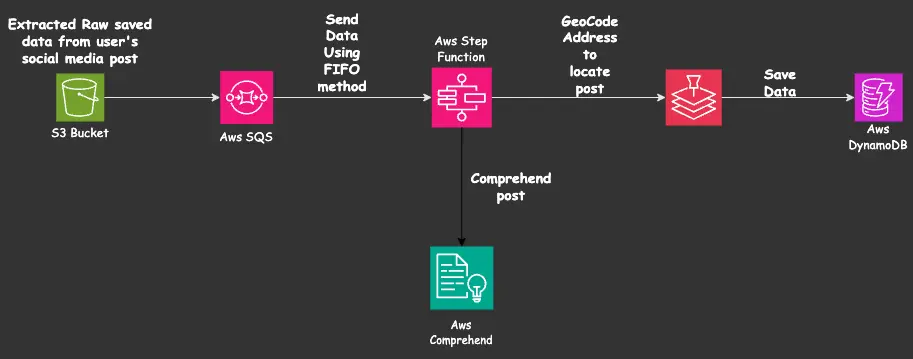
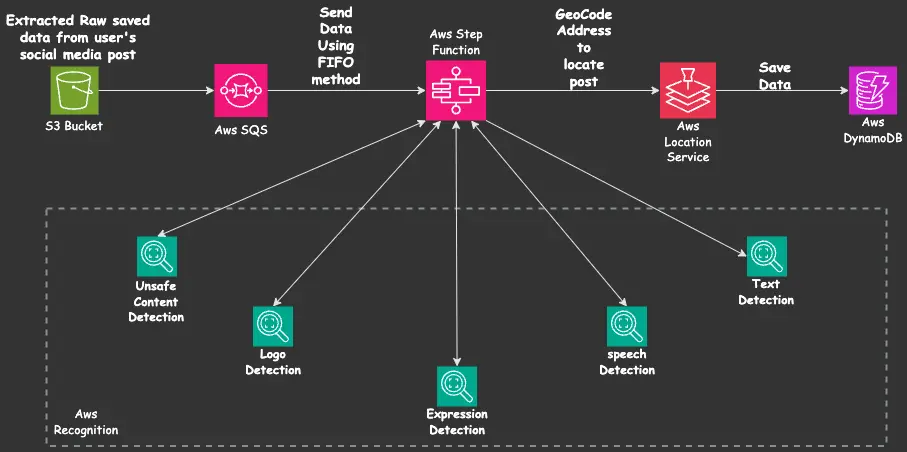
Analyze data in DynamoDB with Amazon Athena Federated Query
Since we're dealing with various data sources and are uncertain about the scale of analytics needed, it's wise to opt for a lightweight querying solution. Athena comes into play here, using data source connectors running on AWS Lambda for federated queries. These connectors translate between our data sources and Athena, automatically detecting metadata before each query. Additionally, we can use the AWS Glue Data Catalog to supplement metadata for connectors, especially useful when a data source lacks its metadata source, like DynamoDB. To share analysis results across teams, a custom dashboard is created using AWS Quicksight
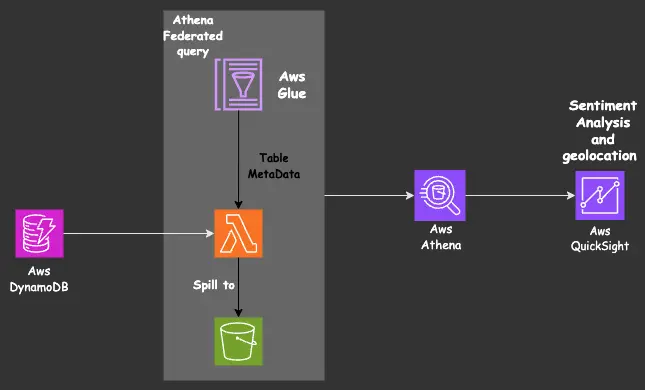
Frontend
In this setup, we're using three databases: two AWS DynamoDB and one AWS relational database. These databases are connected to auto scaling-enabled EC2 services through an API Gateway.
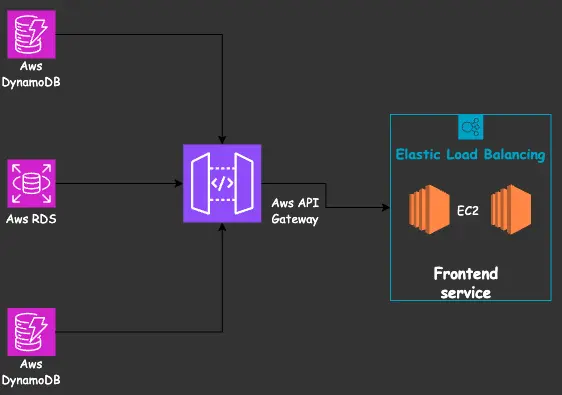
Article Photo by Jimmy Connover







